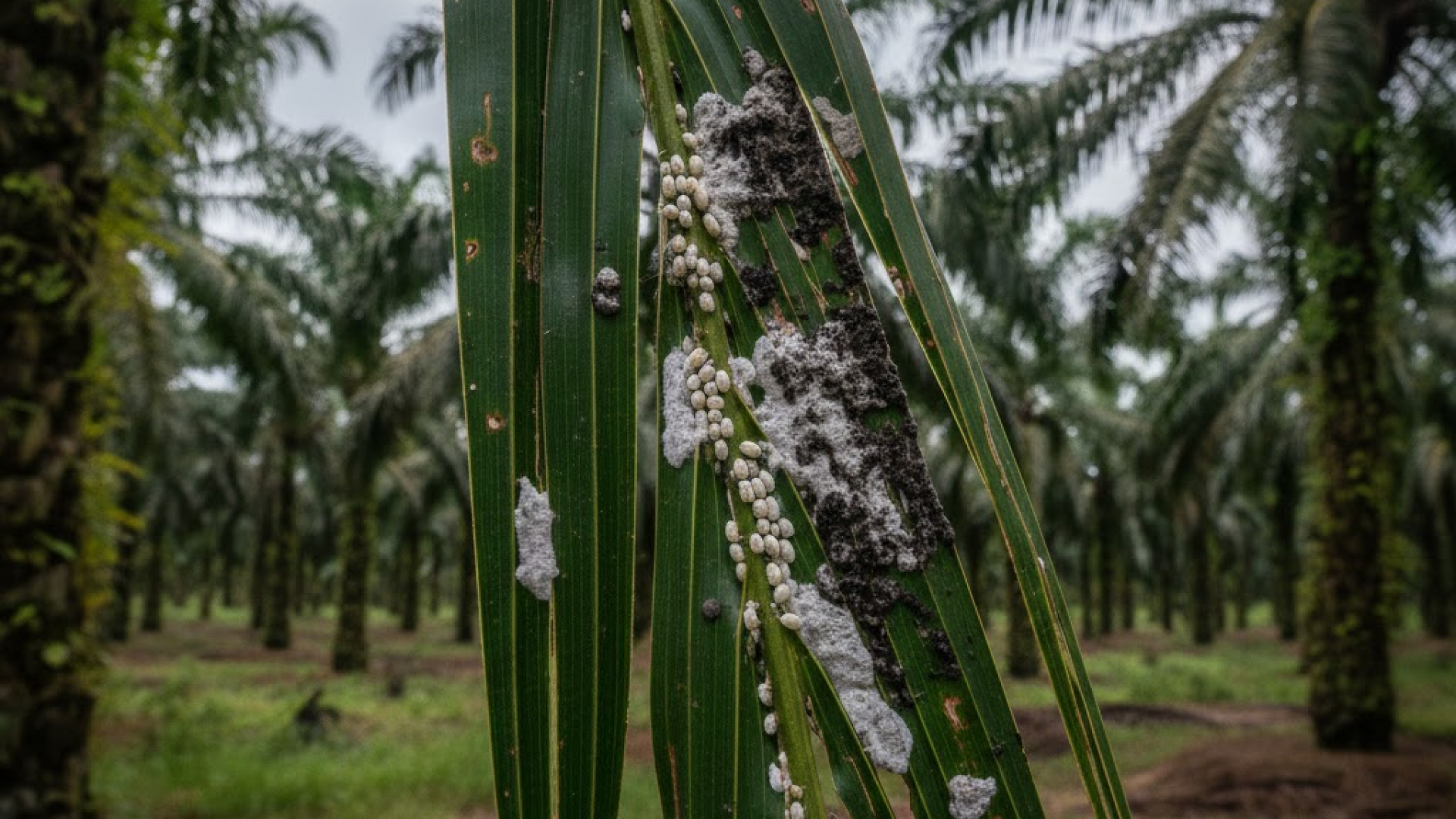When a plantation in Sorong, Southwest Papua, began noticing white insects clustering on palm fronds, the signs were unmistakable: a mealybug infestation had taken hold. Within weeks, the affected areas darkened as sooty mold spread across the leaves, coating them in a black fungal layer.
These two problems are closely linked. Mealybugs feed on plant sap and excrete honeydew, which becomes the growth medium for sooty mold. The result: reduced photosynthesis, weakened palms, and declining yields.
For plantation managers, time is critical. Once mealybugs spread across multiple blocks, controlling them with ground spraying becomes slow and inconsistent, especially in areas with uneven terrain or tall canopies.
This is where agricultural spraying drones delivered a faster and more targeted solution.
When Traditional Spraying Isn’t Enough
Manual or ground spraying relies heavily on labor and accessibility. Workers with knapsack sprayers can only reach the lower fronds, while vehicle-mounted rigs are restricted by terrain and canopy height. Coverage gaps are common, and spray drift or runoff often wastes chemicals.
Moreover, when pest pressure increases rapidly, manual spraying teams struggle to keep up. By the time they finish treating one block, the pests have already moved to new growth areas.
To respond faster and more accurately, the plantation engaged Terra Agri, a provider of drone-based spraying solutions for large-scale agriculture.

Deploying the Drone Solution
The operation in Sorong began as a controlled trial and later scaled up into a full deployment covering over 3,000 hectares. Terra Agri used its E16 agriculture spraying drones, known for their stability, precision, and ease of maintenance in remote locations.
Drone Configuration and Calibration
Each E16 drone featured a 16-liter tank with dual nozzles calibrated to produce 80–120-micron droplets, the optimal size for achieving canopy penetration and uniform leaf coverage.
Before the first application, Terra Agri conducted calibration flights to define:
– Optimal flight altitude: 3.5 meters above the canopy to ensure leaf coverage while minimizing drift.
– Flight speed: 4–5 m/s, adjusted for canopy density and wind direction.
– Spray flow rate: 1.2–1.5 L/min per nozzle, controlled via onboard pressure sensors.
– Spray width: 4–6 meters per flight path, with 20% overlap to ensure complete coverage.
Operators programmed these parameters into the drone’s flight management software to maintain consistent droplet deposition across all missions.
Field Operations Setup
Terra Agri organized the field operation into mobile units, each consisting of:
– 2 drones
– 4 trained pilots and assistants
– 1 chemical mixing technician
– 1 logistics driver
Each mobile unit worked from a modified truck that served as a mobile base, complete with charging stations, mixing tanks, and battery storage. This design kept operations running smoothly between plantation blocks.
On average, each drone completed 8–10 sorties per day, covering approximately 15 hectares daily under normal field conditions. Flight paths were pre-mapped using GPS coordinates and boundary data provided by the plantation.

Quality Assurance and Monitoring
During spraying, Terra Agri’s field supervisors monitored key variables, including:
– The team verified droplet uniformity by placing water-sensitive paper in the canopy.
– They measured wind speed and direction with portable anemometers before each sortie.
– They monitored battery temperature and voltage via telemetry to maintain safe operation. Data from each mission was logged and analyzed to confirm spray coverage and identify potential adjustment points for subsequent blocks.
Field Results
After several weeks of treatment, the plantation observed visible improvement. The white, waxy mealybug clusters decreased substantially, and the black sooty mold film began to fade as leaf surfaces recovered.
Operationally, drone spraying shortened treatment cycles from several weeks to a matter of days for each zone. By rotating multiple drones, Terra Agri maintained continuous coverage even in challenging terrain.
While specific metrics remain confidential, the project showed clear improvements in chemical use, coverage consistency, and pest suppression, prompting the client to adopt drone spraying as part of its long-term pest management strategy.
Lessons from the Sorong Operation
The Sorong project demonstrated that drone spraying is a scalable, data-driven approach to sustainable plantation health. With accurate calibration, trained pilots, and efficient logistics, drone technology can deliver measurable gains in speed, coverage, and safety even in remote regions with complex field conditions.
The Sorong project demonstrated that drone spraying is not only an effective response tool but also a strategic asset for long-term pest management. Key lessons include the value of consistent data collection, rapid deployment during outbreaks, and reduced chemical dependency. Overall, drone operations improved efficiency, ensured uniform coverage, and helped the plantation shift from reactive control to preventive management.

